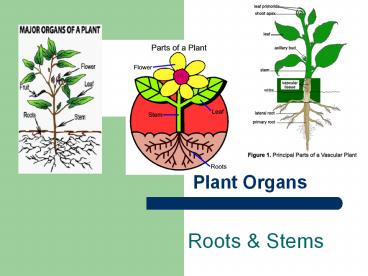Plant Organs - PowerPoint PPT Presentation
Title:
Plant Organs
Description:
Plant Organs Roots & Stems – PowerPoint PPT presentation
Number of Views:53
Avg rating:3.0/5.0
Title: Plant Organs
1
Plant Organs
- Roots Stems
2
I. Roots
- A. F(x)s grow underground
- 1. Absorb water nutrients from soil
- 2. Anchor plant in the soil
- 3. Make hormones important for growth
- development
3
I. Roots
- B. Structure
- 1. Root cap
- F(x) protects apical meristem
4
I. Roots
- B. Structure
- 2. Root hairs
- F(x)
- increase surface area for absorption
5
I. Roots
- B. Structure
- 3. Casparian Strip
- F(x)
- channel water
- dissolved nutrients into vascular tissue
- allow movement only into roots
6
I. Roots
- C. Types of Roots
- 1. Taproots
- a. Large main root that can store food
- b. F(x) absorption,
- anchoring
- E.g.
beet
carrot
7
C. Types of Roots
- 2. Fibrous roots
- a. Numerous small roots
- b. Grow near surface
- c. F(x) absorption,
- anchoring
- c. E.g. grass
8
C. Types of Roots
- 3. Prop or
- Adventitious roots
- a. Grow down to soil from stem,
- above ground
- b. F(x)s support,
absorption - c. E.g. corn,
- banyon tree
9
C. Types of Roots
- 4. Aerial Roots
- a. Grow without soil,
- in air
- b. F(x) absorb water from moist air
- c. E.g. orchids in tropical
rainforest
10
II. Stems
- A. F(x)s
- 1. Hold leaves up to sunlight
- 2. Transport water nutrients from roots to
leaves - 3. Food storage in some plants
11
II. Stems
- B. Stem Structures
- 1. Node place where
- one or more leaves are
- attached
- Note At the point of attachment of each leaf,
- there is a lateral bud with
- an apical meristem
- capable of developing
- into a new shoot
12
II. Stems
- B. Stem Structures
- 2. Internode
- part of stem
- between nodes
13
II. Stems
- C. Specialized stems
- 1. Rhizome horizontal underground stem
- 2. Tuber
- Underground stem w/ buds
- Food storage
- E.g. potato, parsnip
14
II. Stems
- C. Specialized stems
- Bulb
- large bud w/ layers
- Food storage
- Many edible
- E.g. onion, garlic
15
II. Stems
- C. Specialized stems
- 4. Corm
- Upright, thickened underground stem
- Food storage
- Not usually edible
- E.g. shamrock plant (Oxalis)
16
II. Stems
- C. Specialized stems
- 5. Some plants almost
- all stem,
- no leaves
- E.g. cactus
17
II. Stems
- D. Stem growth
- 1. Growth in Length only at tips of stems
where new primary growth occurs via apical
meristems - 2. Growth in Circumference
- width via
- lateral meristems
18
II. Stems
- E. Primary Growth in Stems
- 1. Vascular tissue arranged in
- vascular bundles
- 2. Dicots bundles in a ring around
outside edge - 3. Monocots bundles scattered throughout
stem
19
II. Stems
Dicot stem CS
Vascular bundles
20
II. Stems
- E. Primary Growth in Stems
- 4. Pith center of the stem
- 5. Cortex ground tissue btwn.
- Vascular Bundles epidermis
Vascular bundle
monocot
dicot
21
II. Stems
- F. Secondary Growth in Stems
- Which get wider year after year,
- monocots or dicots?
- DICOTS!
- Most monocots have no secondary growth.
- 1. ?stem width in dicots due to cell in
- vascular cambium
22
II. Stems
- 2. Vascular Cambium arises in vascular bundle
btwn. xylem phloem - 3. Cylinder formed by cambium,
- then secondary xylem inside,
- then secondary phloem on outside of cylinder
23
II. Stems
- G. Woody Stems
- 1. Heartwood
- 2. Sapwood
- 3. Bark
- DRAW THIS!
24
II. Stems
- G. Woody Stems
- 1. Heartwood
- Dark color
- Center of tree trunk
- Dead xylem , no longer transports water
- F(x)
- support
25
II. Stems
- G. Woody Stems
- 2. Sapwood
- Lighter in color
- Nearer to outside of tree trunk
- F(x) transport (live xylem)
- Note In a large diameter tree, heartwood gets
wider, sapwood stays relatively same width
26
II. Stems
- G. Woody Stems
- 3. Bark
- F(x) protection
- Made of cork, cork cambium phloem
27
II. Stems
- H. Stem F(x)s
- 1. Phloem moves sugars
- a. Translocation sugars moved from
source (photosynthesis in leaves) - to sink (where they are stored)
- b. Products of Photosynthesis can move
- in ____?___ direction
- ANY
28
II. Stems
- H. Stem F(x)s
- 1. Phloem moves sugars
- c. Pressure Flow Hypothesis
- i. Sugars PUMPED into sieve tubes
- _at_ the source
- ii. Turgor pressure increase due to water
entering sieve tubes by osmosis
29
(No Transcript)
30
II. Stems
- H. Stem F(x)s
- 2. Xylem moves water nutrients
- a. Cohesion-Tension Theory
- combination of 3 processes
- i. Transpiration
- ii. Cohesion
- iii. Adhesion
31
Transpiration
- In leaves, release of excess water to atmosphere
- Creates negative pressure in xylem
- Replacement water pulled from xylem
- Water enters roots to replace lost water
32
Cohesion
- Water molecules stick to each other pull each
other up narrow xylem tubes - Water is a polar molecule, therefore
- Water molecules attract each other!
33
Adhesion
- Water molecules strongly attracted
- to xylem wall
34
II. Stems
- b. Final words on water movement in plants
- i. Varies with time of day
- ii. Midday stomata open, rapid movement
- iii. Night stomata closed movement stops
- Exception cacti stomata open _at_ night
- Why?
- to minimize water loss































